What Size Chainsaw Do I Need?
- February 8, 2024
- 0 comment
When it comes to maintaining your yard or managing a wooded property, chainsaws are indispensable tools. They simplify tasks like cutting down trees, removing large branches, and chopping wood. However, the vast array of chainsaw sizes can make choosing the right one somewhat challenging. The question, “What size chainsaw do I need?” is common among both novices and seasoned users. The answer depends largely on the nature of the tasks you plan to undertake and the size of the material you’ll be cutting.
Understanding Chainsaw Sizes
The size of a chainsaw is determined by the length of its cutting bar, which is the active cutting area. This measurement is taken from the tip of the chainsaw bar to the point where it enters the housing. It’s crucial to choose a chainsaw with a bar that’s long enough to cut through the wood in a single pass. Generally, it’s recommended that the chainsaw bar should extend at least 2-4 inches beyond the material you are cutting.
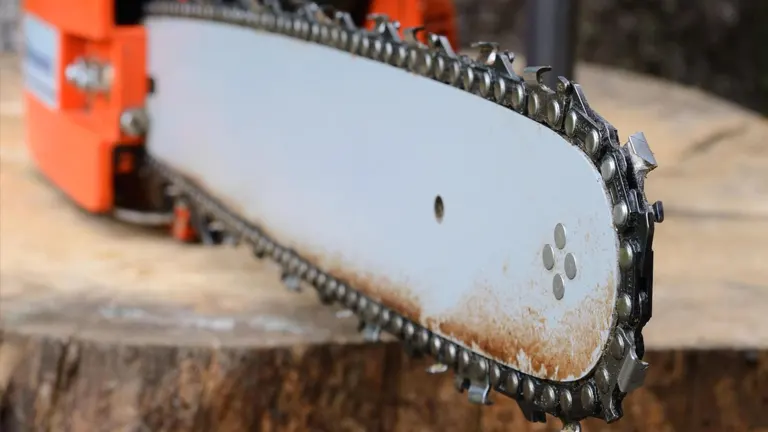
For instance, if you’re planning to cut a tree trunk that is 12 inches in diameter, a chainsaw with a 14-inch or 16-inch bar would be ideal. This ensures that the chainsaw can handle the job efficiently without being oversized for the task.
Choosing the Right Size for Homeowners
For most homeowners, a chainsaw with a bar length between 14″ and 20″ is ideal, depending on the nature of your projects. If your yard work involves trimming small branches or cutting down small trees, a 14″ chainsaw may suffice. However, for those with larger properties or the need to tackle medium-sized trees, a 20″ chainsaw is more appropriate.
Ideal Length for Specific Tasks
- Cutting Down Trees: For fully grown trees with a diameter of 14″-22″, a chainsaw length of 16″-24″ is recommended.
- Pruning Branches & Limbs: Smaller branches and limbs require less power, making a 10″ or 12″ chainsaw sufficient for most pruning tasks.
What If My Chainsaw Is Too Long or Too Short?
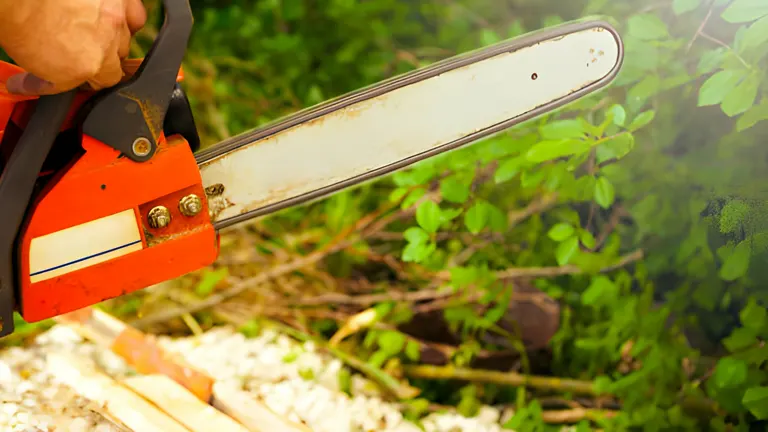
Using a chainsaw that’s too long for the job can increase the risk of kickback and make the tool harder to control due to its weight and vibration. Conversely, a chainsaw that’s too short may not be as efficient or may require creative cutting techniques to complete the job, though it’s less of a safety concern.
Measuring Chainsaw Bar and Chain Size
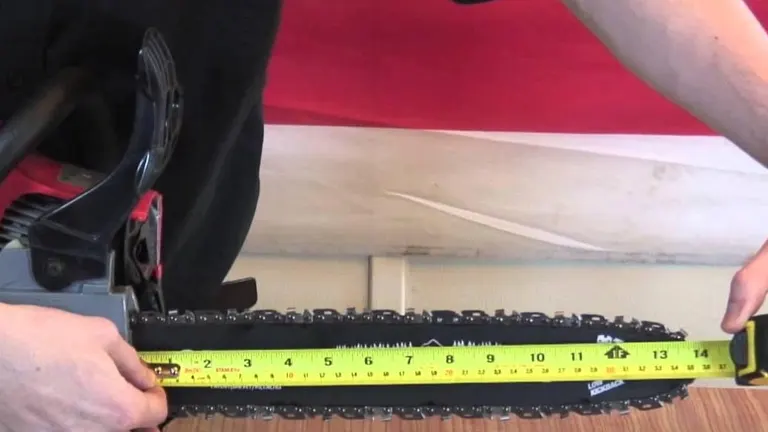
When shopping for a chainsaw, the bar length is usually the key specification, often printed on the blade or detailed in the product’s description. For existing chainsaws, measure from the tip of the bar to the base, near the engine housing, rounding to the nearest even number as chainsaw bars are typically sold in even lengths.
Selecting the Ideal Chainsaw for Your Outdoor Tasks
When it comes to selecting the right chainsaw for your outdoor projects, understanding the nature and scope of your tasks is paramount. The choice of chainsaw significantly impacts the efficiency, ease, and safety with which you can complete your work.
- Light Chores: Opt for a chainsaw with a bar length of less than 16 inches for tasks like light cutting and detailed pruning. These smaller chainsaws are perfect for precision work, offering better control and less fatigue, making them ideal for occasional yard maintenance and minor cleanups.
- General Use: Chainsaws with bar lengths between 16 and 18 inches strike a perfect balance of versatility and power. They are capable of handling a broad range of tasks, from cutting through thick branches to managing moderate logs. This size range is recommended for homeowners looking for a go-to chainsaw that can tackle most tasks with relative ease.
- Heavy-Duty Work: When you’re facing extensive tree and brush clearance or need to cut through large logs, a 20-inch chainsaw becomes indispensable. Its larger size and more powerful engine are designed to take on demanding tasks, providing the necessary strength to cut through tough materials efficiently.
Task-Specific Recommendations
- Pruning Limbs: For the delicate task of pruning, a chainsaw blade measuring 6-10 inches is usually more than sufficient. These smaller chainsaws allow for greater precision and easier handling, ensuring you can shape and maintain your trees and shrubs without causing unnecessary damage.
- Branch Removal: For removing thicker branches that require a bit more power, a chainsaw with an 8-12 inch blade is recommended. This size offers a good compromise between maneuverability and cutting capability, allowing you to work through medium-sized branches effectively.
- Cutting Small Trees: If your project involves cutting down small trees, aim for a chainsaw with a minimum bar length of 12 inches, though models with 14-inch bars may provide that extra reach and power for slightly larger trees. This size range ensures you can cut through the trunk efficiently while still being able to manage the chainsaw comfortably.
- Felling Large Trees: For the most challenging task of cutting down large trees, you’ll need a chainsaw equipped with a blade length of 20 inches or more. These chainsaws are built for heavy-duty work, featuring powerful motors that can handle the rigors of cutting through thick trunks. The longer bar length allows for cutting larger diameter trees in a single pass, making your job quicker and more efficient.
Consider Your Experience and Physical Strength
When selecting a chainsaw, it’s crucial to take into account not just the task at hand but also your own ability to handle the tool safely and effectively. The length of the chainsaw bar directly impacts its manageability and the user’s control over the equipment. Longer bars, while useful for cutting through thick materials, can be more challenging to control, particularly for those with limited experience using chainsaws. This can increase the risk of accidents due to kickback—a sudden upward or backward motion of the bar towards the operator.
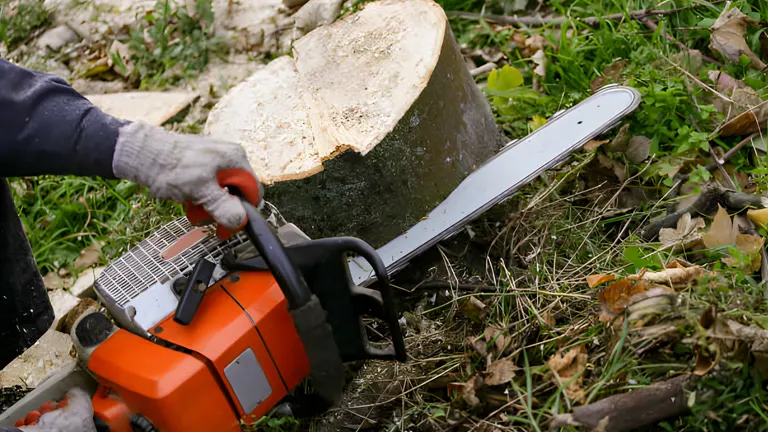
To mitigate these risks, look for chainsaws equipped with safety features designed to enhance control and reduce kickback, such as low-kickback bars and chains. These features are essential for both novice and experienced users, as they significantly enhance the safety of chainsaw operation.
Another factor to consider is your physical strength. Operating a chainsaw, especially for extended periods, requires a good deal of physical effort. Heavier chainsaws can lead to quicker fatigue, making the task not only more difficult but also potentially unsafe. Lighter models or those with ergonomic designs can make a significant difference in usability, particularly for those who may not have the physical strength to handle a heavier machine comfortably.
Best Size Chainsaw for Cutting Firewood
One of the most common uses for chainsaws among homeowners is cutting firewood. For this task, a chainsaw with a bar length of 12 to 16 inches is often the best choice. This size range offers a good balance between cutting capability and ease of use, making it suitable for cutting through the typical sizes of firewood logs.
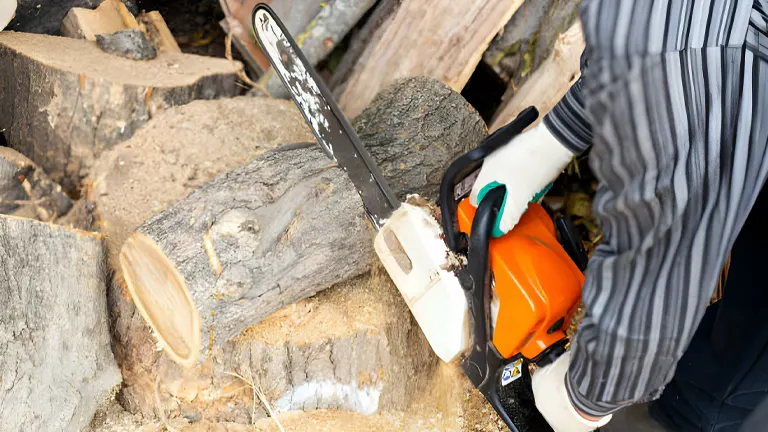
A 12-inch chainsaw is lightweight and manageable, ideal for smaller logs and those new to using chainsaws. A 16-inch chainsaw, on the other hand, provides a bit more cutting capacity, making it suitable for larger logs while still being relatively easy for most people to handle.
Ultimately, the best chainsaw size for cutting firewood depends on the average size of the wood you intend to cut and your comfort with handling the chainsaw. For most homeowners, staying within this range will ensure that the chainsaw is both effective for the task and manageable in terms of physical effort and safety.
Swapping to a Shorter Bar: Is It Possible?
Yes, most chainsaws are designed to accommodate up to three different bar sizes, offering a spectrum of versatility. However, the range of sizes available for substitution will depend on the chainsaw’s make and model, with some allowing for a dramatic span from 14 to 40 inches, while others may offer a more limited selection.
Considerations for Changing the Chainsaw Bar
Before you embark on replacing your chainsaw bar, there are essential components to consider to ensure a safe and effective modification:
- Oiler Nipple Alignment: The oiler nipple plays a crucial role in delivering regular lubrication to the bar, especially in chainsaws equipped with automatic oilers. When selecting a new bar, confirm that its specifications align with the oiler nipple to maintain proper lubrication during operation.
- Chain Compatibility: Switching the bar necessitates a corresponding change in the chain to ensure it fits the new bar’s diameter correctly. The chain must match the pitch measurement of the new bar to prevent operational hazards, such as the chain slipping off or snapping under pressure.
- Sprocket Consideration: The sprocket, integral to driving the chain via the engine’s power, must be compatible with the new chain’s drive links. An ill-fitting chain can wear down the sprocket or lead to a dangerous chain failure.
Conclusion
Selecting the right size chainsaw involves considering the nature of your projects, your experience, and physical capabilities. By understanding the tasks at hand and evaluating the recommended chainsaw sizes, you can ensure safe, efficient, and effective cutting for all your outdoor needs. Remember, the best chainsaw is one that not only fits the job but also feels comfortable and safe in your hands.
FAQs
- Can I use a larger chainsaw than recommended for small projects to save time?
While it might seem like using a larger chainsaw could save time, it can actually make the job harder and more dangerous. Larger chainsaws are heavier, create more vibration, and are more likely to cause fatigue, reducing precision and increasing the risk of kickback. - How does the type of wood affect the size of chainsaw I should use?
The hardness and density of the wood can influence the ideal chainsaw size. Hardwoods like oak or maple may require a more powerful chainsaw (possibly with a longer bar) than softer woods like pine, even if the diameter of the wood is the same. - Is there a difference in chainsaw size needs between felling a tree and cutting it into logs?
Yes, felling a tree often requires a chainsaw with a longer bar to manage the tree’s full diameter safely. However, once the tree is down, cutting it into logs might be easier with a shorter, more maneuverable chainsaw, especially if the logs are moved to a cutting area where they can be easily rotated and positioned. - Can weather conditions influence the chainsaw size I need?
In extreme cold, chainsaws can be harder to start and operate. In such conditions, you might prefer a chainsaw that is easier to handle and maintain, possibly opting for a slightly smaller model than you would use in warmer weather to ensure reliability and ease of use. - How does elevation affect my chainsaw’s performance, and should it influence the size I choose?
Elevation can affect a chainsaw’s engine performance due to thinner air at higher altitudes, which reduces engine power and efficiency. If you’re working at high elevations, consider a chainsaw with a more powerful engine to compensate for this loss of power, which might mean choosing a model that’s slightly larger or more robust than you would at lower altitudes. - Are there ergonomic considerations when choosing the size of a chainsaw?
Absolutely. Ergonomics play a crucial role in preventing fatigue and injury. A chainsaw that is too large and heavy for the user can lead to improper handling techniques, increasing the risk of accidents. Consider the chainsaw’s weight, handle design, and balance when choosing the size to ensure it’s a good fit for your strength and stature. - How do I know if a chainsaw is too big or too small for me before I buy it?
Before purchasing, try holding the chainsaw in the store to gauge its weight and balance. Some retailers might even have demo models that you can hold or run briefly. Ensure you can comfortably lift, hold, and simulate cutting motions without strain. If it feels awkward or too heavy, consider a different size. - Can I modify a smaller chainsaw to make it suitable for larger tasks?
Modifying a chainsaw to extend its bar length or power is not recommended. Such modifications can void warranties, compromise safety features, and lead to unsafe operating conditions. It’s better to choose a chainsaw that’s appropriately sized for your tasks from the start. - Is there a “universal” chainsaw size that works for most tasks around a typical home?
While there’s no one-size-fits-all answer due to varying property sizes and tree types, a chainsaw with a 16- to 18-inch bar is often versatile enough for most tasks around a typical home, from trimming branches to cutting down medium-sized trees. - How often should I reassess my chainsaw size needs?
Reassess your chainsaw size needs if your property changes (e.g., you move to a home with more or larger trees), if the nature of your outdoor projects evolves, or if you find that your current chainsaw no longer meets your needs due to changes in physical strength or comfort with the tool.
We hope this guide has illuminated the path to finding your perfect chainsaw size, but the conversation doesn’t end here! We’d love to hear about your experiences, tips, or any questions you might have. Have you found a chainsaw size that works wonders for your projects? Or maybe you’re still on the hunt for that ideal fit? Drop us a comment below and share your chainsaw stories or queries. Your insights could be the guiding light for fellow readers navigating their chainsaw choices. Let’s keep the dialogue going and help each other make informed, safe, and effective decisions in our outdoor endeavors. Happy cutting!

David Murray
Forestry AuthorI'm David Murry, a forestry equipment specialist with a focus on chainsaw operation. With over 13 years of experience, I've honed my skills in operating and maintaining a wide range of machinery, from chainsaws to log splitters. My passion for the outdoors and commitment to sustainable forestry drive my work, which emphasizes safety, efficiency, and staying updated with industry advancements. Additionally, I'm dedicated to sharing my expertise and promoting environmental awareness within the forestry community.




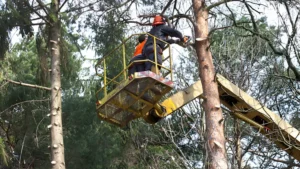








Leave your comment